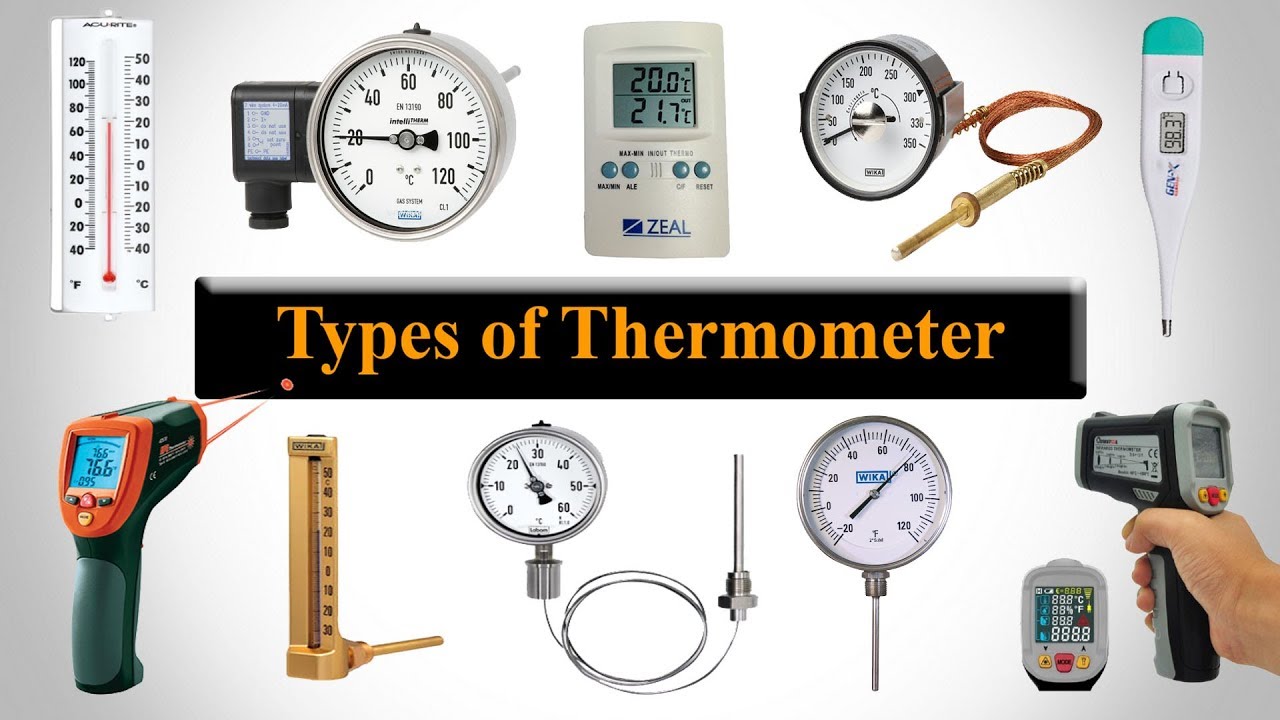Temperature
A temperature is a unit of measurement which indicates how much a body is heated. Kelvin is con the SI unit of temperature (K); however, the temperature is also expressed in degrees Celsius (°C) or degrees Fahrenheit (°F).
Thermometer
Galileo devised a crude water thermometer in 1593, dubbed the thermoscope. The thermoscope, on the other hand, proved inefficient when the water froze at very low temperatures.
Gabriel Fahrenheit developed the current mercury thermometer in 1714. The stem of a thermometer is a long, thin, homogeneous glass tube. The temperature scales are indicated on the stem.
At the tip of the stem, you may find a tiny bulb containing mercury, which rises as the temperature changes.
The glass stem contains a capillary tube through which mercury expands when the bulb comes in touch with a heated body.
Mercury is very dangerous, and disposing of it once the thermometer breaks is quite difficult. As a result, digital thermometers are generally utilized to take temperature readings, as mercury is not present within it.
Thermometers Come in a Variety of Forms
There are several kinds of thermometers used to determine the temperatures of various objects such as air, human bodies, and food. Clinical thermometers, Galileo thermometers, laboratory thermometers, maximum-minimum thermometers, and remote digital thermometers are all available.
Clinical thermometers and laboratory thermometers are the most frequently used thermometers.
Thermometer for Clinical Use - Clinical Thermometer
It is the thermometer that is used to determine the body temperature.
When we develop a fever, the doctor uses a clinical thermometer to determine the temperature of the body.
Structure of a thermometer
This thermometer is made out of a long glass tube with a narrow and consistent diameter. At one end of the glass tube, you may find a mercury-filled glass bulb.
A kink in the glass tube of a clinical thermometer is located just above the mercury-containing bulb. This kink prevents mercury from being reintroduced into the thermometer bulb the moment the thermometer bulb is withdrawn from a patient's mouth. This kink in the thermometer tube also stops the mercury level from naturally decreasing. As a result, we can determine the patient's accurate body temperature even after withdrawing the thermometer bulb from his lips.
Various features of a Clinical Thermometer
A clinical thermometer is capable of displaying temperatures between 35°C and 42°C. Under typical conditions, our body temperature should be between 36.5°C and 37.5°C.
The limited range of a clinical thermometer is due to the fact that the human body's temperature seldom falls below 35°C or rises over 42°C.
After taking the body temperature, the mercury level may be lowered by jerking the thermometer tube.
Scale of Temperature in Clinical Thermometer
On each side of the mercury thread, you may find temperature scales, one side displays Celsius, and the other side displays Fahrenheit. Due to the fact that the Fahrenheit scale is more accurate and responsive than the Celsius system, body temperature is always expressed in degrees Fahrenheit.
Precautionary measures to be taken while making use of a Clinical Thermometer
When using a clinical thermometer, the following precautions must be observed.
• Prior to and after usage, the thermometer should be cleaned, particularly with an antiseptic solution.
• Shake the thermometer several times to lower the mercury level.
• The mercury level should be less than 35 °C or 94 °F before usage.
• Avoid grasping the thermometer by the bulb.
• Take the reading with the mercury level parallel to your line of sight.
• Take caution while handling the thermometer. If it collides with a hard item, it may break.
• Avoid placing the thermometer near a heat source or in direct sunlight.
Due to the fact that mercury is very hazardous and difficult to discard of, thermometers must be handled with care.
The clinical thermometer must not be utilized to determine the temperature of any other human body.
Using a Clinical Thermometer to get a temperature reading
To read the temperature on a thermometer, you must follow the provided procedures.
Step I. To begin, clean the thermometer using an antiseptic solution or, if none is accessible, put some clean water on a cloth and wipe the thermometer.
Step II: Lightly shake the thermometer tube in your palm until the mercury thread in the thermometer tube reads less than 35°C.
Step III: Place the thermometer's bulb beneath the patient's tongue for approximately one minute. After then, pull the thermometer out of the patient's mouth.
To measure the temperature, keep the thermometer in a horizontal position with one hand and gently spin it. A position will become apparent when we observe an enlarged picture of the mercury thread in its tube. Next, measure the temperature on the thermometer tube that is parallel to the mercury thread's top.
Thermometer for Laboratory Use - Laboratory Thermometer.
Because the clinical thermometer could not be used to measure anything other than the human body, scientists devised a new thermometer called the laboratory thermometer.
The laboratory thermometer measures temperatures in the range of 10°C to 110°C.
In a scientific laboratory, a laboratory thermometer is also used to determine the temperature.
Laboratory Thermometer Structure
In comparison to the clinical thermometer, it features a longer, narrower tube (Stem) and bulb.
The best aspect of a Laboratory thermometer is that it is free of kinks. A laboratory thermometer's graduated tube can measure temperatures ranging from -10°C to 110°C.
When taking temperature measurements, bear in mind that every laboratory thermometer division has a slightly different reading. This thermometer features a little division, often known as the thermometer's least count.
Safety precautions to be taken while utilizing a Laboratory Thermometer.
⦁ While taking the temperature, avoid tilting the thermometer and maintain the thermometer in an upright position.
⦁ Take the reading only when the fluid has completely encircled the bulb.
⦁ Assure that the bulb does not come into contact with the container's bottom or sides.
⦁ While performing the measurements, avoid moving the thermometer.
To know more about various types of thermometers and see them in action, check out our videos on this topic.


